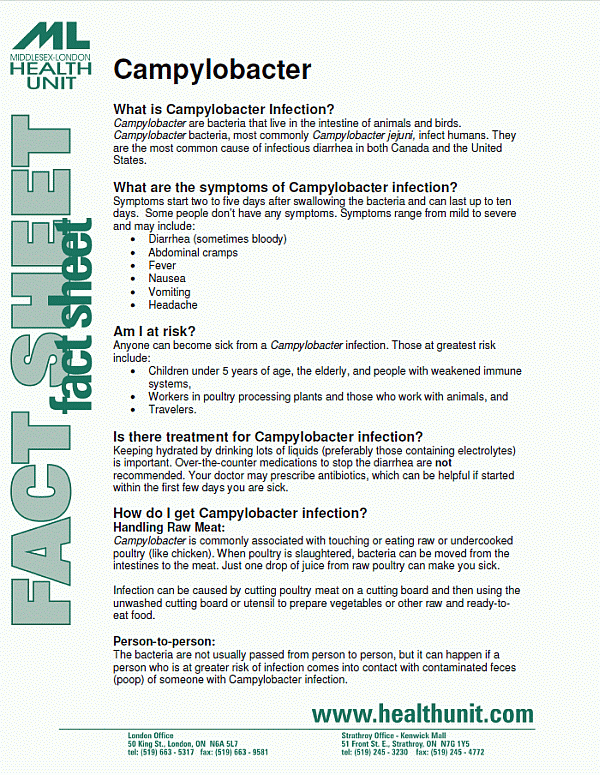Contact Us
For more information, please contact the Infectious Disease Control Team:
- 519-663-5317 Ext. 2330
 Campylobacter Fact Sheet (PDF 90KB)
Campylobacter Fact Sheet (PDF 90KB)For more information, please contact the Infectious Disease Control Team:
Symptoms start two to five days after swallowing the bacteria and can last up to ten days. Some people don’t have any symptoms. Symptoms range from mild to severe and may include:
Anyone can become sick from a Campylobacter infection. Those at greatest risk include:
Keeping hydrated by drinking lots of liquids (preferably those containing electrolytes) is important. Your doctor may prescribe antibiotics, which can be helpful if started within the first few days you are sick.
Please note: Over-the-counter medications to stop the diarrhea are not recommended.
Campylobacter is commonly associated with touching or eating raw or undercooked poultry (like chicken). When poultry is slaughtered, bacteria can be transferred from the intestines to the meat. Just one drop of juice from raw poultry can make you sick.
Infection can be caused by cutting poultry meat on a cutting board and then using the unwashed cutting board or utensil to prepare vegetables or other raw and ready-to-eat food. Knowing about safe food handling at home will prevent you from becoming ill.
The bacteria are not usually passed from person to person, but it can happen if a person who is at greater risk of infection comes into contact with contaminated feces (poop) of someone with Campylobacter infection.
Outbreaks have been caused by drinking unpasteurized milk or water containing the Campylobacter bacteria. Well water, lakes, streams and beaches can become contaminated from the feces of animals or wild birds.
Animals, including farm animals, puppies and kittens, can carry Campylobacter in their feces, which can get on their fur. Bird feeders can also be a source of Campylobacter bacteria.
Hands can become contaminated after petting an infected animal or cleaning/filling a bird feeder. Infection can happen if the bacteria from your hands are transferred to your mouth.
Campylobacter is common in developing countries. Travelers to developing countries may be at risk of Campylobacter infection.
Safe food handling, proper hand washing and good personal hygiene are the most important ways to prevent getting and passing on Campylobacter infection.
People who have Campylobacter infection should not prepare food for others because they may contaminate the food and make other people sick.
Foods that are contaminated with Campylobacter bacteria do not look or smell bad. Follow tips for safe food handling practices at all times.
Washing hands often and well is the best prevention.